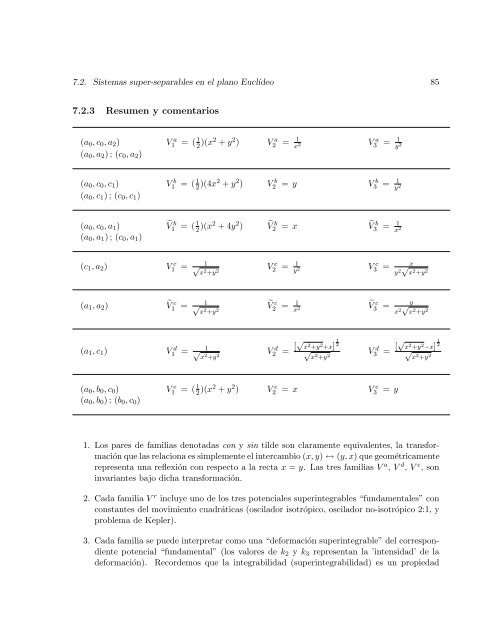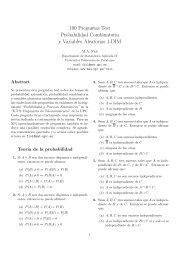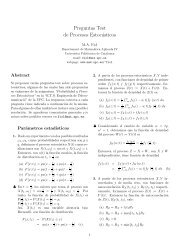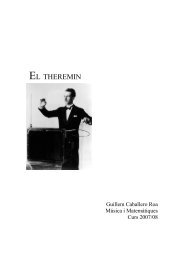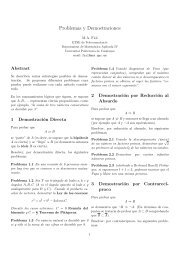Diez lecciones sobre Sistemas Hamiltonianos, Integrabilidad y ...
Diez lecciones sobre Sistemas Hamiltonianos, Integrabilidad y ...
Diez lecciones sobre Sistemas Hamiltonianos, Integrabilidad y ...
You also want an ePaper? Increase the reach of your titles
YUMPU automatically turns print PDFs into web optimized ePapers that Google loves.
7.2. <strong>Sistemas</strong> super-separables en el plano Euclídeo 85<br />
7.2.3 Resumen y comentarios<br />
(a0, c0, a2) V a<br />
1<br />
(a0, a2) ; (c0, a2)<br />
(a0, c0, c1) V b<br />
1<br />
(a0, c1) ; (c0, c1)<br />
(a0, c0, a1)<br />
(a0, a1) ; (c0, a1)<br />
1 = ( 2 )(x2 + y2 ) V a<br />
2<br />
1 = ( 2 )(4x2 + y2 ) V b<br />
2<br />
V b<br />
1 = ( 1<br />
2 )(x2 + 4y 2 )<br />
(c1, a2) V c<br />
1 = √ 1<br />
x2 +y2 (a1, a2)<br />
V c 1<br />
1 = √<br />
x2 +y2 (a1, c1) V d<br />
1 = √ 1<br />
x2 +y2 (a0, b0, c0) V e<br />
1<br />
(a0, b0) ; (b0, c0)<br />
= 1<br />
x 2<br />
V a<br />
3<br />
= y V b<br />
3<br />
= 1<br />
y 2<br />
= 1<br />
y 2<br />
V b<br />
2 = x V b<br />
3 = 1<br />
x 2<br />
V c<br />
2<br />
V c<br />
2<br />
1 = ( 2 )(x2 + y2 ) V e<br />
2<br />
= 1<br />
y 2<br />
= 1<br />
x 2<br />
V d<br />
2 = [√x2 +y2 +x] 1 2<br />
√<br />
x2 +y2 = x V e<br />
3<br />
V c<br />
3 = x<br />
y 2√ x 2 +y 2<br />
V c<br />
3 =<br />
y<br />
x 2√ x 2 +y 2<br />
V d<br />
3 = [√x2 +y2−x] 1 2<br />
√<br />
x2 +y2 1. Los pares de familias denotadas con y sin tilde son claramente equivalentes, la transformación<br />
que las relaciona es simplemente el intercambio (x, y) ↔ (y, x) que geométricamente<br />
representa una reflexión con respecto a la recta x = y. Las tres familias V a , V d , V e , son<br />
invariantes bajo dicha transformación.<br />
2. Cada familia V r incluye uno de los tres potenciales superintegrables “fundamentales” con<br />
constantes del movimiento cuadráticas (oscilador isotrópico, oscilador no-isotrópico 2:1, y<br />
problema de Kepler).<br />
3. Cada familia se puede interpretar como una “deformación superintegrable” del correspondiente<br />
potencial “fundamental” (los valores de k2 y k3 representan la ’intensidad’ de la<br />
deformación). Recordemos que la integrabilidad (superintegrabilidad) es un propiedad<br />
= y


